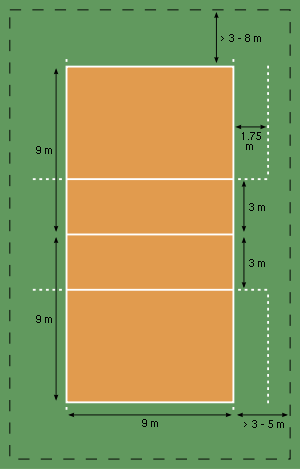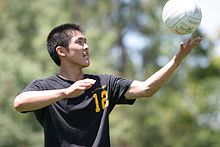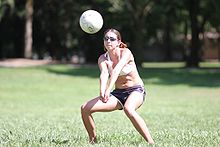- Volleyball
-
For other uses, see Volleyball (disambiguation)."V-ball" redirects here. For the cricket variant, see V-Ball cricket.
Volleyball 
Typical volleyball actionHighest governing body FIVB First played 1895, Holyoke, Massachusetts, United States Characteristics Contact No contact Team members 6 Mixed gender Single Categorization Indoor, beach, grass Equipment Volleyball Olympic 1964 Volleyball is a team sport in which two teams of six players are separated by a net. Each team tries to score points by grounding a ball on the other team's court under organized rules.[1]
The complete rules are extensive. But simply, play proceeds as follows: A player on one of the teams begins a 'rally' by serving the ball (tossing or releasing it and then hitting it with a hand or arm), from behind the back boundary line of the court, over the net, and into the receiving team's court. The receiving team must not let the ball be grounded within their court. They may touch the ball as many as three times. Typically, the first two touches are to set up for an attack, an attempt to direct the ball back over the net in such a way that the serving team is unable to prevent it from being grounded in their court.
The rally continues, with each team allowed as many as three consecutive touches, until either (1): a team makes a kill, grounding the ball on the opponent's court and winning the rally; or (2): a team commits a fault and loses the rally. The team that wins the rally is awarded a point, and serves the ball to start the next rally. A few of the most common faults include:
- causing the ball to touch the ground outside the opponents' court or without first passing over the net;
- catching and throwing the ball;
- double hit: two consecutive contacts with the ball made by the same player;
- four consecutive contacts with the ball made by the same team.
- net foul: touching the net during play.
The ball is usually played with the hands or arms, but players can legally strike or push (short contact) the ball with any part of the body.
A number of consistent techniques have evolved in volleyball, including spiking and blocking (because these plays are made above the top of the net, the vertical jump is an athletic skill emphasized in the sport) as well as passing, setting, and specialized player positions and offensive and defensive structures.
Contents
History
Origin of volleyball
On February 9, 1895, in Holyoke, Massachusetts (USA), William G. Morgan, a YMCA physical education director, created a new game called Mintonette as a pastime to be played preferably indoors and by any number of players. The game took some of its characteristics from tennis and handball. Another indoor sport, basketball, was catching on in the area, having been invented just ten miles (sixteen kilometers) away in the city of Springfield, Massachusetts, only four years before. Mintonette was designed to be an indoor sport less rough than basketball for older members of the YMCA, while still requiring a bit of athletic effort.
The first rules, written down by William G Morgan, called for a net 6 ft 6 in (1.98 m) high, a 25×50 ft (7.6×15.2 m) court, and any number of players. A match was composed of nine innings with three serves for each team in each inning, and no limit to the number of ball contacts for each team before sending the ball to the opponents’ court. In case of a serving error, a second try was allowed. Hitting the ball into the net was considered a foul (with loss of the point or a side-out)—except in the case of the first-try serve.
After an observer, Alfred Halstead, noticed the volleying nature of the game at its first exhibition match in 1896, played at the International YMCA Training School (now called Springfield College), the game quickly became known as volleyball (it was originally spelled as two words: "volley ball"). Volleyball rules were slightly modified by the International YMCA Training School and the game spread around the country to various YMCAs.[2][3]
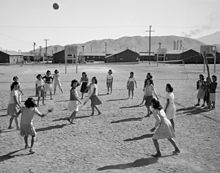 Japanese American women playing volleyball, Manzanar internment camp, California, ca. 1943.
Japanese American women playing volleyball, Manzanar internment camp, California, ca. 1943.
Refinements and later developments
The first official ball used in volleyball is disputed; some sources say that Spalding created the first official ball in 1896, while others claim it was created in 1900.[4][5][6] The rules evolved over time: in the Philippines by 1916, the skill and power of the set and spike had been introduced, and four years later a "three hits" rule and a rule against hitting from the back row were established. In 1917, the game was changed from 21 to 15 points. In 1919, about 16,000 volleyballs were distributed by the American Expeditionary Forces to their troops and allies, which sparked the growth of volleyball in new countries.[4]
The first country outside the United States to adopt volleyball was Canada in 1900.[4] An international federation, the Fédération Internationale de Volleyball (FIVB), was founded in 1947, and the first World Championships were held in 1949 for men and 1952 for women.[7] The sport is now popular in Brazil, in Europe (where especially Italy, the Netherlands, and countries from Eastern Europe have been major forces since the late 1980s), in Russia, and in other countries including China and the rest of Asia, as well as in the United States.[2][3][7]
Beach volleyball, a variation of the game played on sand and with only two players per team, became a FIVB-endorsed variation in 1987 and was added to the Olympic program at the 1996 Summer Olympics.[4][7] Volleyball is also a sport at the Paralympics managed by the World Organization Volleyball for Disabled.
Volleyball in the Olympics
Main article: Volleyball at the Summer OlympicsThe history of Olympic volleyball traces back to the 1924 Summer Olympics in Paris, where volleyball was played as part of an American sports demonstration event.[8] After the foundation of FIVB and some continental confederations, it began to be considered for official inclusion. In 1957, a special tournament was held at the 53rd IOC session in Sofia, Bulgaria to support such request. The competition was a success, and the sport was officially included in the program for the 1964 Summer Olympics.[4]
The Olympic volleyball tournament was originally a simple competition: all teams played against each other team and then were ranked by wins, set average, and point average. One disadvantage of this round-robin system is that medal winners could be determined before the end of the games, making the audience lose interest in the outcome of the remaining matches. To cope with this situation, the competition was split into two phases with the addition of a "final round" elimination tournament consisting of quarterfinals, semifinals, and finals matches in 1972. The number of teams involved in the Olympic tournament has grown steadily since 1964. Since 1996, both men's and women's events count twelve participant nations. Each of the five continental volleyball confederations has at least one affiliated national federation involved in the Olympic Games.
The U.S.S.R. won men's gold in both 1964 and 1968. After taking bronze in 1964 and silver in 1968, Japan finally won the gold for men's volleyball in 1972. Women's gold went to Japan in 1964 and again in 1976. That year, the introduction of a new offensive skill, the backrow attack, allowed Poland to win the men's competition over the Soviets in a very tight five-set match. Since the strongest teams in men's volleyball at the time belonged to the Eastern Bloc, the American-led boycott of the 1980 Summer Olympics did not have as great an effect on these events as it had on the women's. The U.S.S.R. collected their third Olympic Gold Medal in men's volleyball with a 3–1 victory over Bulgaria (the Soviet women won that year as well, their third gold as well). With the U.S.S.R. boycotting the 1984 Olympic Games in Los Angeles, the U.S. was able to sweep Brazil in the finals to win the men's gold medal. Italy won its first medal (bronze in the men's competition) in 1984, foreshadowing a rise in prominence for their volleyball teams.
At the 1988 Games, Karch Kiraly and Steve Timmons led the U.S. men's team to a second straight gold medal. In 1992, underrated Brazil upset favourites C.I.S., Netherlands, and Italy in the men's competition for the country's first volleyball Olympic gold medal. Runner-up Netherlands, men's silver medalist in 1992, came back under team leaders Ron Zwerver and Olof van der Meulen in the 1996 Games for a five-set win over Italy. A men's bronze medalist in 1996, Serbia and Montenegro (playing in 1996 and 2000 as the Federal Republic of Yugoslavia) beat Russia in the gold medal match in 2000, winning their first gold medal ever. In 2004, Brazil won its second men's volleyball gold medal beating Italy in the finals. In the 2008 Games, the USA beat Brazil in the men's volleyball final.
Rules of the game
The court
The game is played on a volleyball court 18 meters (59 feet) long and 9 meters (29.5 feet) wide, divided into two 9 m × 9 m halves by a one-meter (40-inch) wide net placed so that the top of the net is 2.43 meters (7 feet 11 5/8 inches) above the center of the court for men's competition, and 2.24 meters (7 feet 4 1/8 inches) for women's competition (these heights are varied for veterans and junior competitions).
There is a line 3 meters from and parallel to the net in each team court which is considered the "attack line". This "3 meter" (or 10 foot) line divides the court into "back row" and "front row" areas (also back court and front court). These are in turn divided into 3 areas each: these are numbered as follows, starting from area "1", which is the position of the serving player:
After a team gains the serve (also known as siding out), its members must rotate in a clockwise direction, with the player previously in area "2" moving to area "1" and so on, with the player from area "1" moving to area "6".
The team courts are surrounded by an area called the free zone which is a minimum of 3 meters wide and which the players may enter and play within after the service of the ball.[9] All lines denoting the boundaries of the team court and the attack zone are drawn or painted within the dimensions of the area and are therefore a part of the court or zone. If a ball comes in contact with the line, the ball is considered to be "in". An antenna is placed on each side of the net perpendicular to the sideline and is a vertical extension of the side boundary of the court. A ball passing over the net must pass completely between the antennae (or their theoretical extensions to the ceiling) without contacting them.
The ball
Main article: Volleyball (ball)FIVB regulations state that the ball must be spherical, made of leather or synthetic leather, have a circumference of 65–67 cm, a weight of 260–280 g and an inside pressure of 0.30–0.325 kg/cm2.[10] Other governing bodies have similar regulations.
Game play
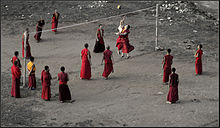 Buddhist monks play volleyball in the Himalayan state of Sikkim, India.
Buddhist monks play volleyball in the Himalayan state of Sikkim, India.
Each team consists of six players. To get play started, a team is chosen to serve by coin toss. A player from the serving team throws the ball into the air and attempts to hit the ball so it passes over the net on a course such that it will land in the opposing team's court (the serve). The opposing team must use a combination of no more than three contacts with the volleyball to return the ball to the opponent's side of the net. These contacts usually consist first of the bump or pass so that the ball's trajectory is aimed towards the player designated as the setter; second of the set (usually an over-hand pass using wrists to push finger-tips at the ball) by the setter so that the ball's trajectory is aimed towards a spot where one of the players designated as an attacker can hit it, and third by the attacker who spikes (jumping, raising one arm above the head and hitting the ball so it will move quickly down to the ground on the opponent's court) to return the ball over the net. The team with possession of the ball that is trying to attack the ball as described is said to be on offense.
The team on defense attempts to prevent the attacker from directing the ball into their court: players at the net jump and reach above the top (and if possible, across the plane) of the net in order to block the attacked ball. If the ball is hit around, above, or through the block, the defensive players arranged in the rest of the court attempt to control the ball with a dig (usually a fore-arm pass of a hard-driven ball). After a successful dig, the team transitions to offense.
The game continues in this manner, rallying back and forth, until the ball touches the court within the boundaries or until an error is made. The most frequent errors that are made are either to fail to return the ball over the net within the allowed three touches, or to cause the ball to land outside the court. A ball is "in" if any part of it touches a sideline or end-line, and a strong spike may compress the ball enough when it lands that a ball which at first appears to be going out may actually be in. Players may travel well outside the court to play a ball that has gone over a sideline or end-line in the air.
Other common errors include a player touching the ball twice in succession, a player "catching" the ball, a player touching the net while attempting to play the ball, or a player penetrating under the net into the opponent's court. There are a large number of other errors specified in the rules, although most of them are infrequent occurrences. These errors include back-row or libero players spiking the ball or blocking (back-row players may spike the ball if they jump from behind the attack line), players not being in the correct position when the ball is served, attacking the serve in the front court and above the height of the net, using another player as a source of support to reach the ball, stepping over the back boundary line when serving, taking more than 8 seconds to serve,[11] or playing the ball when it is above the opponent's court.
Scoring
When the ball contacts the floor within the court boundaries or an error is made, the team that did not make the error is awarded a point, whether they served the ball or not. If the ball hits the line, the ball is counted as in. The team that won the point serves for the next point. If the team that won the point served in the previous point, the same player serves again. If the team that won the point did not serve the previous point, the players of the team rotate their position on the court in a clockwise manner. The game continues, with the first team to score 25 points (and be two points ahead) awarded the set. Matches are best-of-five sets and the fifth set (if necessary) is usually played to 15 points. (Scoring differs between leagues, tournaments, and levels; high schools sometimes play best-of-three to 25; in the NCAA games are played best-of-five to 25 as of the 2008 season.)[12]
Before 1999, points could be scored only when a team had the serve (side-out scoring) and all sets went up to only 15 points. The FIVB changed the rules in 1999 (with the changes being compulsory in 2000) to use the current scoring system (formerly known as rally point system), primarily to make the length of the match more predictable and to make the game more spectator- and television-friendly.
Libero
In 1998 the libero player was introduced internationally.[13] The libero is a player specialized in defensive skills: the libero must wear a contrasting jersey color from his or her teammates and cannot block or attack the ball when it is entirely above net height. When the ball is not in play, the libero can replace any back-row player, without prior notice to the officials. This replacement does not count against the substitution limit each team is allowed per set, although the libero may be replaced only by the player whom they replaced.
The libero may function as a setter only under certain restrictions. If she/he makes an overhand set, she/he must be standing behind (and not stepping on) the 3-meter line; otherwise, the ball cannot be attacked above the net in front of the 3-meter line. An underhand pass is allowed from any part of the court.
The libero is, generally, the most skilled defensive player on the team. There is also a libero tracking sheet, where the referees or officiating team must keep track of who the libero subs in and out for. There may only be one libero per set (game), although there may be a different libero in the beginning of any new set (game).
Furthermore, a libero is not allowed to serve, according to international rules, with the exception of the NCAA women's volleyball games, where a 2004 rule change allows the libero to serve, but only in a specific rotation. That is, the libero can only serve for one person, not for all of the people for whom he or she goes in. That rule change was also applied to high school and junior high play soon after.
Recent rule changes
Other rule changes enacted in 2000 include allowing serves in which the ball touches the net, as long as it goes over the net into the opponents' court. Also, the service area was expanded to allow players to serve from anywhere behind the end line but still within the theoretical extension of the sidelines. Other changes were made to lighten up calls on faults for carries and double-touches, such as allowing multiple contacts by a single player ("double-hits") on a team's first contact provided that they are a part of a single play on the ball.
In 2008, the NCAA changed the minimum number of points needed to win any of the first four sets from 30 to 25 for women's volleyball (men's volleyball remained at 30.) If a fifth (deciding) set is reached, the minimum required score remains at 15. In addition, the word "game" is now referred to as "set".[12]
Changes in rules have been studied and announced by FIVB in recent years, and they have released the updated rules in 2009.[14]
Skills
Competitive teams master six basic skills: serve, pass, set, attack, block and dig. Each of these skills comprises a number of specific techniques that have been introduced over the years and are now considered standard practice in high-level volleyball.
Serve
A player stands behind the inline and serves the ball, in an attempt to drive it into the opponent's court. His or her main objective is to make it land inside the court; it is also desirable to set the ball's direction, speed and acceleration so that it becomes difficult for the receiver to handle it properly. A serve is called an "ace" when the ball lands directly onto the court or travels outside the court after being touched by an opponent.
In contemporary volleyball, many types of serves are employed:
- Underhand: a serve in which the player strikes the ball below the waist instead of tossing it up and striking it with an overhand throwing motion. Underhand serves are considered very easy to receive and are rarely employed in high-level competitions.
- Sky ball serve: a specific type of underhand serve occasionally used in beach volleyball, where the ball is hit so high it comes down almost in a straight line. This serve was invented and employed almost exclusively by the Brazilian team in the early 1980s and is now considered outdated. In Brazil, this serve is called Jornada nas Estrelas (Star Trek).
- Topspin: an overhand serve where the player tosses the ball high and hits it with a wrist span, giving it topspin which causes it to drop faster than it would otherwise and helps maintain a straight flight path. Topspin serves are generally hit hard and aimed at a specific returner or part of the court. Standing topspin serves are rarely used above the high school level of play.
- Float: an overhand serve where the ball is hit with no spin so that its path becomes unpredictable, akin to a knuckleball in baseball.
- Jump serve: an overhand serve where the ball is first tossed high in the air, then the player makes a timed approach and jumps to make contact with the ball, hitting it with much pace and topspin. This is the most popular serve amongst college and professional teams.
- Jump float: an overhand serve where the ball is tossed high enough that the player may jump before hitting it similarly to a standing float serve. The ball is tossed lower than a topspin jump serve, but contact is still made while in the air. This serve is becoming more popular amongst college and professional players because it has a certain unpredictability in its flight pattern.
Set
The set is usually the second contact that a team makes with the ball. The main goal of setting is to put the ball in the air in such a way that it can be driven by an attack into the opponent's court. The setter coordinates the offensive movements of a team, and is the player who ultimately decides which player will actually attack the ball.
As with passing, one may distinguish between an overhand and a bump set. Since the former allows for more control over the speed and direction of the ball, the bump is used only when the ball is so low it cannot be properly handled with fingertips, or in beach volleyball where rules regulating overhand setting are more stringent. In the case of a set, one also speaks of a front or back set, meaning whether the ball is passed in the direction the setter is facing or behind the setter. There is also a jump set that is used when the ball is too close to the net. In this case the setter usually jumps off his or her right foot straight up to avoid going into the net. The setter usually stands about ⅔ of the way from the left to the right of the net and faces the left (the larger portion of net that he or she can see).
Sometimes a setter refrains from raising the ball for a teammate to perform an attack and tries to play it directly onto the opponent's court. This movement is called a "dump".[15] The most common dumps are to 'throw' the ball behind the setter or in front of the setter to zones 2 and 4. More experienced setters toss the ball into the deep corners or spike the ball on the second hit.
Pass
Also called reception, the pass is the attempt by a team to properly handle the opponent's serve, or any form of attack. Proper handling includes not only preventing the ball from touching the court, but also making it reach the position where the setter is standing quickly and precisely.
The skill of passing involves fundamentally two specific techniques: underarm pass, or bump, where the ball touches the inside part of the joined forearms or platform, at waist line; and overhand pass, where it is handled with the fingertips, like a set, above the head. Either are acceptable in professional and beach volleyball, however there are much tighter regulations on the overhand pass in beach volleyball.
Attack
The attack, also known as the spike, is usually the third contact a team makes with the ball. The object of attacking is to handle the ball so that it lands on the opponent's court and cannot be defended. A player makes a series of steps (the "approach"), jumps, and swings at the ball.
Ideally the contact with the ball is made at the apex of the hitter's jump. At the moment of contact, the hitter's arm is fully extended above his or her head and slightly forward, making the highest possible contact while maintaining the ability to deliver a powerful hit. The hitter uses arm swing, wrist snap, and a rapid forward contraction of the entire body to drive the ball. A 'bounce' is a slang term for a very hard/loud spike that follows an almost straight trajectory steeply downward into the opponent's court and bounces very high into the air. A "kill" is the slang term for an attack that is not returned by the other team thus resulting in a point.
Contemporary volleyball comprises a number of attacking techniques:
- Backcourt (or backrow)/pipe attack: an attack performed by a back row player. The player must jump from behind the 3-meter line before making contact with the ball, but may land in front of the 3-meter line.
- Line and Cross-court Shot: refers to whether the ball flies in a straight trajectory parallel to the side lines, or crosses through the court in an angle. A cross-court shot with a very pronounced angle, resulting in the ball landing near the 3-meter line, is called a cut shot.
- Dip/Dink/Tip/Cheat/Dump: the player does not try to make a hit, but touches the ball lightly, so that it lands on an area of the opponent's court that is not being covered by the defense.
- Tool/Wipe/Block-abuse: the player does not try to make a hard spike, but hits the ball so that it touches the opponent's block and then bounces off-court.
- Off-speed hit: the player does not hit the ball hard, reducing its speed and thus confusing the opponent's defense.
- Quick hit/"One": an attack (usually by the middle blocker) where the approach and jump begin before the setter contacts the ball. The set (called a "quick set") is placed only slightly above the net and the ball is struck by the hitter almost immediately after leaving the setter's hands. Quick attacks are often effective because they isolate the middle blocker to be the only blocker on the hit.
- Slide: a variation of the quick hit that uses a low back set. The middle hitter steps around the setter and hits from behind him or her.
- Double quick hit/"Stack"/"Tandem": a variation of quick hit where two hitters, one in front and one behind the setter or both in front of the setter, jump to perform a quick hit at the same time. It can be used to deceive opposite blockers and free a fourth hitter attacking from backcourt, maybe without block at all.
Block
Blocking refers to the actions taken by players standing at the net to stop or alter an opponent's attack.
A block that is aimed at completely stopping an attack, thus making the ball remain in the opponent's court, is called offensive. A well-executed offensive block is performed by jumping and reaching to penetrate with one's arms and hands over the net and into the opponent's area. It requires anticipating the direction the ball will go once the attack takes place. It may also require calculating the best foot work to executing the "perfect" block.
The jump should be timed so as to intercept the ball's trajectory prior to it crossing over the net. Palms are held deflected downward about 45–60 degrees toward the interior of the opponents court. A "roof" is a spectacular offensive block that redirects the power and speed of the attack straight down to the attacker's floor, as if the attacker hit the ball into the underside of a peaked house roof.
By contrast, it is called a defensive, or "soft" block if the goal is to control and deflect the hard-driven ball up so that it slows down and becomes more easy to be defended. A well-executed soft-block is performed by jumping and placing one's hands above the net with no penetration into the opponent's court and with the palms up and fingers pointing backward.
Blocking is also classified according to the number of players involved. Thus, one may speak of single (or solo), double, or triple block.
Successful blocking does not always result in a "roof" and many times does not even touch the ball. While it’s obvious that a block was a success when the attacker is roofed, a block that consistently forces the attacker away from his or her 'power' or preferred attack into a more easily controlled shot by the defense is also a highly successful block.
At the same time, the block position influences the positions where other defenders place themselves while opponent hitters are spiking.
Dig
Digging is the ability to prevent the ball from touching one's court after a spike or attack, particularly a ball that is nearly touching the ground. In many aspects, this skill is similar to passing, or bumping: overhand dig and bump are also used to distinguish between defensive actions taken with fingertips or with joined arms.
Some specific techniques are more common in digging than in passing. A player may sometimes perform a "dive", i.e., throw his or her body in the air with a forward movement in an attempt to save the ball, and land on his or her chest. When the player also slides his or her hand under a ball that is almost touching the court, this is called a "pancake". The pancake is frequently used in indoor volleyball.
Sometimes a player may also be forced to drop his or her body quickly to the floor in order to save the ball. In this situation, the player makes use of a specific rolling technique to minimize the chances of injuries.
Coaching
Basic
Coaching for volleyball can be classified under two main categories: match coaching and developmental coaching. The objective of match coaching is to win a match by managing a team's strategy. Developmental coaching emphasizes player development through the reinforcement of basic skills during exercises known as "drills." Drills promote repetition and refinement of volleyball movements, particularly in footwork patterns, body positioning relative to others, and ball contact. A coach will construct drills that simulate match situations thereby encouraging speed of movement, anticipation, timing, communication, and team-work. At the various stages of a player's career, a coach will tailor drills to meet the strategic requirements of the team. The American Volleyball Coaches Association is the largest organization in the world dedicated exclusively to volleyball coaching.
Strategy
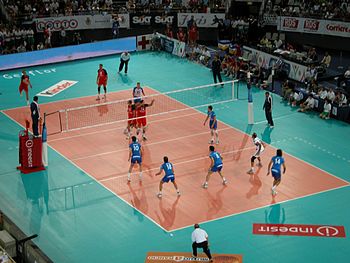 An image from an international match between Italy and Russia in 2005. A Russian player on the left has just served, with three men of his team next to the net moving to their assigned block positions from the starting ones. Two others, in the back-row positions, are preparing for defense. Italy, on the right, has three men in a line, each preparing to pass if the ball reaches him. The setter is waiting for their pass while the middle hitter with no. 10 will jump for a quick hit if the pass is good enough. Alessandro Fei (no. 14) has no passing duties and is preparing for a back-row hit on the right side of the field. Note the two liberos with different color dress. Middle hitters/blockers are commonly substituted by liberos in their back-row positions.
An image from an international match between Italy and Russia in 2005. A Russian player on the left has just served, with three men of his team next to the net moving to their assigned block positions from the starting ones. Two others, in the back-row positions, are preparing for defense. Italy, on the right, has three men in a line, each preparing to pass if the ball reaches him. The setter is waiting for their pass while the middle hitter with no. 10 will jump for a quick hit if the pass is good enough. Alessandro Fei (no. 14) has no passing duties and is preparing for a back-row hit on the right side of the field. Note the two liberos with different color dress. Middle hitters/blockers are commonly substituted by liberos in their back-row positions.
Player specialization
There are 5 positions filled on every volleyball team at the elite level. Setter, Outside Hitter/Left Side Hitter, Middle Hitter, Opposite Hitter/Right Side Hitter and Libero/Defensive Specialist. Each of these positions plays a specific, key role in winning a volleyball match.
- Setters have the task for orchestrating the offense of the team. They aim for second touch and their main responsibility is to place the ball in the air where the attackers can place the ball into the opponents' court for a point. They have to be able to operate with the hitters, manage the tempo of their side of the court and choose the right attackers to set. Setters need to have swift and skillful appraisal and tactical accuracy, and must be quick at moving around the court.
- Liberos are defensive players who are responsible for receiving the attack or serve. They are usually the players on the court with the quickest reaction time and best passing skills. Libero means 'free' as they have the ability to substitute for any other player on the court during each play. They do not necessarily need to be tall, as they never play at the net, which allows shorter players with strong passing and defensive skills to excel in the position and play an important role in the team's success. A player designated as a libero for a match may not play other roles during that match. Liberos wear a different color jersey than their teammates.
- Middle blockers or Middle hitters are players that can perform very fast attacks that usually take place near the setter. They are specialized in blocking, since they must attempt to stop equally fast plays from their opponents and then quickly set up a double block at the sides of the court. In non-beginners play, every team will have two middle hitters.
- Outside hitters or Left side hitters attack from near the left antenna. The outside hitter is usually the most consistent hitter on the team and gets the most sets. Inaccurate first passes usually result in a set to the outside hitter rather than middle or opposite. Since most sets to the outside are high, the outside hitter may take a longer approach, always starting from outside the court sideline. In non-beginners play, there are again two outside hitters on every team in every match.
- Opposite hitters or Right side hitters carry the defensive workload for a volleyball team in the front row. Their primary responsibilities are to put up a well formed block against the opponents Outside Hitters and serve as a backup setter. Sets to the opposite usually go to the right side of the antennae.
Formations
The three standard volleyball formations are known as "4–2", "6–2" and "5–1", which refers to the number of hitters and setters respectively. 4–2 is a basic formation used only in beginners' play, while 5–1 is by far the most common formation in high-level play.
4–2
The 4–2 formation has four hitters and two setters. The setters usually set from the middle front or right front position. The team will therefore have two front-row attackers at all times. In the international 4–2, the setters set from the right front position. The international 4–2 translates more easily into other forms of offense.
The setters line up opposite each other in the rotation. The typical lineup has two outside hitters. By aligning like positions opposite themselves in the rotation, there will always be one of each position in the front and back rows. After service, the players in the front row move into their assigned positions, so that the setter is always in middle front. Alternatively, the setter moves into the right front and has both a middle and an outside attacker; the disadvantage here lies in the lack of an offside hitter, allowing one of the other team's blockers to "cheat in" on a middle block.
The clear disadvantage to this offensive formation is that there are only two attackers, leaving a team with fewer offensive weapons.
Another aspect is to see the setter as an attacking force, albeit a weakened force, because when the setter is in the front court they are able to 'tip' or 'dump', so when the ball is close to the net on the second touch, the setter may opt to hit the ball over with one hand. This means that the blocker who would otherwise not have to block the setter is engaged and may allow one of the hitters to have an easier attack.
6–2
In the 6–2 formation, a player always comes forward from the back row to set. The three front row players are all in attacking positions. Thus, all six players act as hitters at one time or another, while two can act as setters. So the 6–2 formation is actually a 4–2 system, but the back-row setter penetrates to set.
The 6–2 lineup thus requires two setters, who line up opposite to each other in the rotation. In addition to the setters, a typical lineup will have two middle hitters and two outside hitters. By aligning like positions opposite themselves in the rotation, there will always be one of each position in the front and back rows. After service, the players in the front row move into their assigned positions.
The advantage of the 6–2 is that there are always three front-row hitters available, maximizing the offensive possibilities. However, not only does the 6–2 require a team to possess two people capable of performing the highly specialized role of setter, it also requires both of those players to be effective offensive hitters when not in the setter position. At the international level, only the Cuban National Women's Team employs this kind of formation. It is also used in Women's NCAA play, partially due to the variant rules used which allow 12[16] substitutions per set (as opposed to the 6 allowed in the standard rules).
5–1
The 5–1 formation has only one player who assumes setting responsibilities regardless of his or her position in the rotation. The team will therefore have three front-row attackers when the setter is in the back row, and only two when the setter is in the front row, for a total of five possible attackers.
The player opposite the setter in a 5–1 rotation is called the opposite hitter. In general, opposite hitters do not pass; they stand behind their teammates when the opponent is serving. The opposite hitter may be used as a third attack option (back-row attack) when the setter is in the front row: this is the normal option used to increase the attack capabilities of modern volleyball teams. Normally the opposite hitter is the most technical skilled hitter of the team. Back-row attacks generally come from the back-right position,known as zone 1, but are increasingly performed from back-center in high-level play.
The big advantage of this system is that the setter always has 3 hitters to vary sets with. If the setter does this well, the opponent's middle blocker may not have enough time to block with the outside blocker, increasing the chance for the attacking team to make a point.
There is another advantage, the same as that of a 4–2 formation: when the setter is a front-row player, he or she is allowed to jump and "dump" the ball onto the opponent's side. This too can confuse the opponent's blocking players: the setter can jump and dump or can set to one of the hitters. A good setter knows this and thus won't only jump to dump or to set for a quick hit, but when setting outside as well to confuse the opponent.
The 5–1 offense is actually a mix of 6–2 and 4–2: when the setter is in the front row, the offense looks like a 4–2; when the setter is in the back row, the offense looks like a 6–2.
Main article: Volleyball variationsThere are many variations on the basic rules of volleyball. By far the most popular of these is beach volleyball, which is played on sand with two people per team, and rivals the main sport in popularity.
Some games related to volleyball include:
- Footvolley: A sport from Brazil in which the hands and arms are not used but most else is like beach volleyball.
- Hooverball: Popularized by President Herbert Hoover, it is played with a volleyball net and a medicine ball; it is scored like tennis, but the ball is caught and then thrown back. The weight of the medicine ball can make the sport to be quite physically demanding; annual championship tournaments are held annually in West Branch, Iowa.
- Newcomb ball (sometimes spelled "Nuke 'Em"): In this game, the ball is caught and thrown instead of hit; it rivaled volleyball in popularity until the 1920s.
- Prisoner Ball: Also played with volleyball court and a volleyball, the object of the game is to get your opponents "out".
- Throwball became popular with women players at the YMCA College of Physical Education in Chennai (India) in the 1940s.
- Buka ball: This is a rather similar game played only with the feet.
- Beachball volleyball: A game of indoor volleyball played with a beach ball instead of a volleyball.
See also
- List of volleyball video games
- Volleyball Hall of Fame
- Volleyball in Canada
- Volleyball in the United States
- Volleyball jargon
Notes
- ^ "Volleyball". International Olympic Committee. http://www.olympic.org/uk/sports/programme/index_uk.asp?SportCode=VB. Retrieved 2007-03-21.
- ^ a b "The Volleyball Story". Fédération Internationale de Volleyball (FIVB). http://www.fivb.com/EN/volleyball/story.htm. Retrieved 2007-09-21.
- ^ a b "How Volleyball Began". Northern California Volleyball Association. http://www.ncva.com/page.aspx?id=14. Retrieved 2007-09-21.
- ^ a b c d e "History Of Volleyball". Volleyball World Wide. http://volleyball.org/history.html. Retrieved 2007-09-21.
- ^ "History of Volleyball". SportsKnowHow.com. http://www.sportsknowhow.com/volleyball/history/volleyball-history.shtml. Retrieved 2007-09-21.
- ^ "History of Volleyball". volleyball.com. http://www.volleyball.com/volleyball_history.aspx. Retrieved 2007-09-21.
- ^ a b c "FIVB History". Fédération Internationale de Volleyball. http://www.fivb.ch/EN/FIVB/History.htm. Retrieved 2007-09-21.
- ^ "Chronological Highlights". FIVB. http://www.fivb.org/TheGame/ChronologicalHighlights.htm. Retrieved 2007-01-30. "1924: The Olympic Games in Paris. The programme included a demonstration of "American" sports, and Volleyball was among these."
- ^ "Section 1.1" (PDF). Official Volleyball Rules 2011-2012. FIVB. 2010. http://www.fivb.org/EN/Refereeing-Rules/Documents/FIVB.2011-2012.VB.RulesOfTheGame.Eng.TextfileOnly.2.1.1.pdf. Retrieved 2011-10-27. "The playing court is [...] surrounded by a free zone which is a minimum of 3 m wide on all sides."
- ^ "Section 3.1" (PDF). Official Volleyball Rules 2011-2012. FIVB. 2010. http://www.fivb.org/EN/Refereeing-Rules/Documents/FIVB.2011-2012.VB.RulesOfTheGame.Eng.TextfileOnly.2.1.1.pdf. Retrieved 2011-10-27. "STANDARDS The ball shall be spherical ..."
- ^ "Section 12.4.4" (PDF). Official Volleyball Rules 2011-2012. FIVB. 2010. http://www.fivb.org/EN/Refereeing-Rules/Documents/FIVB.2011-2012.VB.RulesOfTheGame.Eng.TextfileOnly.2.1.1.pdf. Retrieved 2011-10-27. "The server must hit the ball within 8 seconds after the first referee whistles for service."
- ^ a b "2008 Major Rules-Change Proposals". ncaa.org. National Collegiate Athletic Association. 2008-07-14. http://www.ncaa.org/wps/wcm/connect/resources/file/ebcecd09e29bb24/Summaryofchanges-final_post-PROP.pdf?MOD=AJPERES. Retrieved 2008-10-12.[dead link]
- ^ The term, meaning "free" in Italian, is pronounced LEE-beh-ro (although many players and coaches pronounce it lih-BEAR-oh. The American NCAA introduced the libero in 2002.Pettit, Terry; and Potts, Kerri (2002-02-28). "Rules changes for the 2002 season". NCAA Women's Volleyball Rules Committee. http://www1.ncaa.org/membership/governance/sports_and_rules_ctees/playing_rules/volleyball/changes_memo. Retrieved 2007-01-12. "The NCAA Women's Volleyball Rules Committee [...] approved several rules changes for the 2002 women's volleyball season including the use of the libero player"
- ^ "FIVB Official Rules 2009". FIVB. 2009. http://www.fivb.org/EN/Volleyball/Rules/Rules.htm.
- ^ "Volleyball glossary". Cambridge University Volleyball Club. http://www.srcf.ucam.org/cuvc/club/glossary.php. Retrieved 2007-03-20.
- ^ Welcome to AVCA – the American Volleyball Coaches Association
External links
International volleyball FIVB · World Ranking · Olympic Games · World Championship · World Cup · World Grand Champions Cup · World League · World Grand Prix · Club World Championship · Men's Junior World Championship · Women's Junior World Championship · Boys Youth World Championship · Girls Youth World Championship · Youth Olympic Games · European League · All-Africa Games · Asian Games · Asian Cup · Pan American Games · Central American and Caribbean Games · Mediterranean Games · Men's Pan-American Cup · Women's Pan-American Cup · Final Four Cup · Pan Arab Games · Lusophony GamesAfrica 
Asia and Oceania North America South America Europe Men's professional volleyball leagues South America North America Europe CEV Champions League · CEV Top Teams Cup · CEV Cup · Austria · Belgium · Bosnia and Herzegovina · Bulgaria · Croatia · Cyprus · England · Estonia · Finland · France · Germany · Greece · Israel · Italy · Montenegro · Netherlands · Poland · Portugal · Romania · Russia · Serbia · Slovenia · Spain · Sweden · Switzerland · Turkey · UkraineAsia & Oceania AVC Club Championships · China · Indonesia · Iran · Japan · South Korea · Taiwan · Australia · New Zealand · Thailand · VietnamAfrica African Cup of Champions Clubs · AlgeriaOlympic sports Summer sports Archery • Athletics • Badminton • Basketball • Boxing • Canoeing • Cycling • Diving • Equestrian • Field hockey • Fencing • Football • Gymnastics • Handball • Judo • Modern pentathlon • Rowing • Sailing • Shooting • Swimming • Synchronized swimming • Table tennis • Taekwondo • Tennis • Triathlon • Volleyball • Water polo • Weightlifting • Greco-Roman Wrestling
Winter sports Former Olympic sports Baseball • Basque pelota • Cricket • Croquet • Golf • Jeu de paume • Lacrosse • Polo • Rackets • Roque • Rugby union • Softball • Tug of war • Water motorsports
Part of the 2016 program See also: Paralympic sportsCategories:- Volleyball
- Sports rules and regulations
- Sports originating in the United States
Wikimedia Foundation. 2010.


